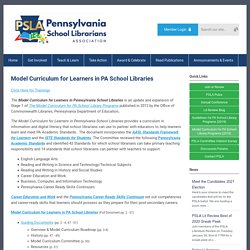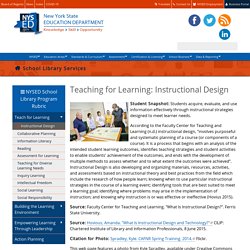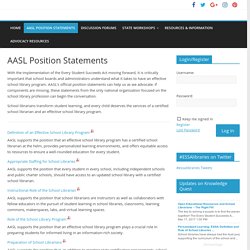

Model Curriculum for Learners in PA School Libraries (2019) Click Here for Trainings The Model Curriculum for Learners in Pennsylvania School Libraries is an update and expansion of Stage 1 of The Model Curriculum for PA School Library Programs published in 2012 by the Office of Commonwealth Libraries, Pennsylvania Department of Education.

The Model Curriculum for Learners in Pennsylvania School Libraries provides a curriculum in information and digital literacy that school librarians can use to partner with educators to help learners learn and meet PA Academic Standards. The document incorporates the AASL Standards Framework for Learners and the ISTE Standards for Students. The Committee reviewed the following Pennsylvania Academic Standards and identified 43 Standards for which school librarians can take primary teaching responsibility and 14 standards that school librarians can partner with teachers to support: Model Curriculum for Learners in PA School Libraries (Full Document pp. 2 - 51)
Instructional Design. Student Snapshot: Students acquire, evaluate, and use information effectively through instructional strategies designed to meet learner needs.

According to the Faculty Center for Teaching and Learning (n.d.) instructional design, “involves purposeful and systematic planning of a course (or components of a course). It is a process that begins with an analysis of the intended student learning outcomes, identifies teaching strategies and student activities to enable students' achievement of the outcomes, and ends with the development of multiple methods to assess whether and to what extent the outcomes were achieved”. School Librarians. Logging into the proxy (Rutgers University Libraries) Logging into the proxy (Rutgers University Libraries) School Libraries - Strategic Planning for Libraries - LibGuides at Massachusetts Library System, Inc. The School Library Media Specialist: Library Media Program: Introduction.
Whether you're planning a Reading Month promotion, designing a new layout for your nonfiction book collection, or developing a technology plan for your entire school district, the problem solving process is the same. Of course the length of the process and complexity of the solution will vary depending on the project, but the data that you collect and the stages you go through will be similar. When is planning important? Program planning is not a "one shot" activity done at the beginning of the year or when applying for a grant. As you consider all the aspects of your role as a library media specialist, always keep in mind the importance of taking a systematic approach to problem solving. Example - as you design your materials collection, you'll need to identify the strong and weak areas of your collection, establish program goals, make selection decisions, acquire materials, and evaluate the collection.
Evaluation Checklist. AASL_Position Statement_Role of the School Library Program_2016-06-25.pdf. AASL Position Statement Effective SLP 2016 06 25. Position Statements – School Libraries & ESSA. With the implementation of the Every Student Succeeds Act moving forward, it is critically important that school boards and administrators understand what it takes to have an effective school library program.

AASL’s official position statements can help us as we advocate. If components are missing, these statements from the only national organization focused on the school library profession can begin the conversation. School librarians transform student learning, and every child deserves the services of a certified school librarian and an effective school library program. Definition of an Effective School Library Program AASL supports the position that an effective school library program has a certified school librarian at the helm, provides personalized learning environments, and offers equitable access to resources to ensure a well-rounded education for every student.